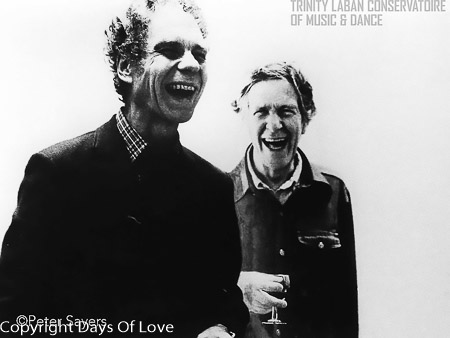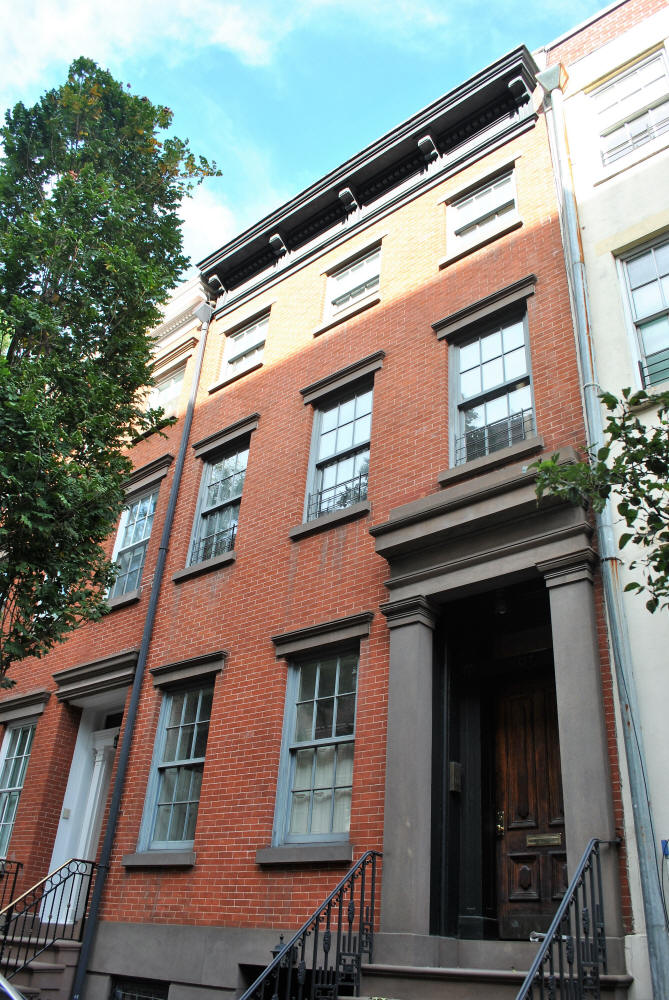Partner Don Sample, Merce Cunningham
Queer Places:
Los Angeles High School, 4650 W Olympic Blvd, Los Angeles, CA 90019, Stati Uniti
University of California, Los Angeles, Los Angeles, California 90095, Stati Uniti
Pomona College, 333 N College Way, Claremont, CA 91711, Stati Uniti
Mills College, 5000 MacArthur Blvd, Oakland, CA 94613, Stati Uniti
Wesleyan University, 45 Wyllys Ave, Middletown, CT 06459, Stati Uniti
136 Melrose Ave E, Seattle, WA 98102
The New School, 72 5th Ave, New York, NY 10011, Stati Uniti
Black Mountain College, Black Mountain, NC 28711, Stati Uniti
107 Bank St, New York, NY 10014, Stati Uniti
326 Monroe St, New York, NY 10002
Ramapo Mountains, Ramapo, NY 10970, Stati Uniti
 John
Milton Cage Jr. (September 5, 1912 – August 12, 1992) was an American composer
and music theorist. A pioneer of indeterminacy in music, electroacoustic
music, and non-standard use of musical instruments, Cage was one of the
leading figures of the post-war avant-garde. Critics have lauded him as one of
the most influential composers of the 20th century.[1][2][3][4]
He was also instrumental in the development of modern dance, mostly through
his association with choreographer
Merce Cunningham,
who was also Cage's romantic partner for most of their lives.[5][6]
John
Milton Cage Jr. (September 5, 1912 – August 12, 1992) was an American composer
and music theorist. A pioneer of indeterminacy in music, electroacoustic
music, and non-standard use of musical instruments, Cage was one of the
leading figures of the post-war avant-garde. Critics have lauded him as one of
the most influential composers of the 20th century.[1][2][3][4]
He was also instrumental in the development of modern dance, mostly through
his association with choreographer
Merce Cunningham,
who was also Cage's romantic partner for most of their lives.[5][6]
In New York in the 1930s, Philip
Johnson ran with a smart young crowd of artists, many of them gay, working
in a range of different art forms, but mainly in music.
Virgil Thomson, whom he had
found penniless in Paris and loaned the cost of his passage home, introduced
him to John Cage in 1934; there was also
Pavel Tchelitchew,
Lincoln Kirstein, Thomson’s
lover Maurice Grosser, and
Aaron Copland. Johnson and Cage
had a fling together, which ended when Johnson failed to invite Cage to a
society party at which Cage felt Johnson felt Cage did not belong. In the same
year, Johnson had what he considered the first of his ‘serious’ relationships,
with
Jimmie Daniels,
a black café singer he had met in Harlem.
Addressing the post-WWI period in his enormous overview of
twentieth-century music, but without the ulterior agenda of the anti-gay
conspiracy theorists, Alex Ross writes: Homosexual men, who make up
approximately 3 to 5 percent of the general population, have played a
disproportionately large role in composition of the last hundred years.
Somewhere around half of the major American composers of the twentieth century
seem to have been homosexual or bisexual:
Aaron Copland,
Virgil Thomson,
Leonard Bernstein,
Samuel Barber,
Marc Blitzstein,
John Cage, Harry
Partch, Henry Cowell,
Lou Harrison,
Gian Carlo Menotti,
David Diamond, and
Ned Rorem, among many others.

107 Bank St
Cage was born September 5, 1912, at Good Samaritan Hospital in downtown Los Angeles.[12] His father, John Milton Cage Sr. (1886–1964), was an inventor, and his mother, Lucretia ("Crete") Harvey (1881–1968), worked intermittently as a journalist for the Los Angeles Times.[13] The family's roots were deeply American: in a 1976 interview, Cage mentioned that George Washington was assisted by an ancestor named John Cage in the task of surveying the Colony of Virginia.[14] Cage described his mother as a woman with "a sense of society" who was "never happy",[15] while his father is perhaps best characterized by his inventions: sometimes idealistic, such as a diesel-fueled submarine that gave off exhaust bubbles, the senior Cage being uninterested in an undetectable submarine;[13] others revolutionary and against the scientific norms, such as the "electrostatic field theory" of the universe.[n 1] John Cage Sr. taught his son that "if someone says 'can't' that shows you what to do." In 1944–45 Cage wrote two small character pieces dedicated to his parents: Crete and Dad. The latter is a short lively piece that ends abruptly, while "Crete" is a slightly longer, mostly melodic contrapuntal work.[16]
At some point in 1934–35, during his studies with Schoenberg, Cage was working at his mother's arts and crafts shop, where he met artist Xenia Andreyevna Kashevaroff. She was an Alaskan-born daughter of a Russian priest; her work encompassed fine bookbinding, sculpture and collage. Although Cage was involved in relationships with
Don Sample and with architect Rudolph Schindler's wife Pauline[18] when he met Xenia, he fell in love immediately. Cage and Kashevaroff were married in the desert at Yuma, Arizona, on June 7, 1935.[40]
They divorced in 1945.
In February 1946, Arthur Gold and Robert Fizdale had a concert at Town Hall, in New York
City. The audience did not resemble others in concert halls, since most of the
people were either artists or members of the international society, including
Perry Empiricos, the son of the Greek
shipping magnate; Georges Bemberg,
whose family in Argentina had caused three revolutions; the beautiful
Peggy
O'Brien and her famous debutante daughter, Esme;
Edelgey Dinshaw and his
sister; the wealthy Oliver and Isa Jennings;
Arturo López Willshaw, another
faboulous Argentinian multimillionaire;
Alice De Lamar with her entourage; as
well as the various princesses and marquesas who surrounded Pavel Tchelitchew.
Peggy Guggenheim was the patroness of the concert. Two major works were
performed, written especially for the occasion by
Paul Bowles and
John Cage,
both of whom Guggenheim admired and encouraged. There was a party afterward at
the apartment of Oliver Smith, in attendance also
Jane Bowles and
John Bernard Myers. As the party
was breaking up, Peter Lindamood accidentally pushed the actress
Stella Adler
down the stairs. She was wearing a Gainsborough-sized hat, and despite the
dramatic tumble, when Stella picked herself up, everything was in place,
including the hat!
Cage is perhaps best known for his 1952 composition 4′33″, which is
performed in the absence of deliberate sound; musicians who present the work
do nothing aside from being present for the duration specified by the title.
The content of the composition is not "four minutes and 33 seconds of
silence," as is often assumed, but rather the sounds of the environment heard
by the audience during performance.[7][8]
The work's challenge to assumed definitions about musicianship and musical
experience made it a popular and controversial topic both in musicology and
the broader aesthetics of art and performance. Cage was also a pioneer of the
prepared piano (a piano with its sound altered by objects placed between or on
its strings or hammers), for which he wrote numerous dance-related works and a
few concert pieces. The best known of these is Sonatas and Interludes
(1946–48).[9]
His teachers included Henry Cowell (1933)
and Arnold Schoenberg (1933–35), both known for their radical innovations in
music, but Cage's major influences lay in various East and South Asian
cultures.
In 1988, Architectural Digest visited their New York loft, noting that Cage
and Cunningham had begun "sharing their lives" after Cage and his wife
separated in the early 1940s.
Through his studies of Indian philosophy and Zen Buddhism in the
late 1940s, Cage came to the idea of aleatoric or chance-controlled music,
which he started composing in 1951.[10]
The I Ching, an ancient Chinese classic text on changing events, became
Cage's standard composition tool for the rest of his life. In a 1957 lecture,
Experimental Music, he described music as "a purposeless play" which is
"an affirmation of life – not an attempt to bring order out of chaos nor to
suggest improvements in creation, but simply a way of waking up to the very
life we're living".[11]
My published books:


BACK TO HOME PAGE

- https://en.wikipedia.org/wiki/John_Cage
- Woods, Gregory. Homintern . Yale University Press. Edizione del
Kindle.
- Hidden Histories, 20th Century Male Same Sex Lovers in the Visual
Arts, by Michael Petry
 John
Milton Cage Jr. (September 5, 1912 – August 12, 1992) was an American composer
and music theorist. A pioneer of indeterminacy in music, electroacoustic
music, and non-standard use of musical instruments, Cage was one of the
leading figures of the post-war avant-garde. Critics have lauded him as one of
the most influential composers of the 20th century.[1][2][3][4]
He was also instrumental in the development of modern dance, mostly through
his association with choreographer
Merce Cunningham,
who was also Cage's romantic partner for most of their lives.[5][6]
John
Milton Cage Jr. (September 5, 1912 – August 12, 1992) was an American composer
and music theorist. A pioneer of indeterminacy in music, electroacoustic
music, and non-standard use of musical instruments, Cage was one of the
leading figures of the post-war avant-garde. Critics have lauded him as one of
the most influential composers of the 20th century.[1][2][3][4]
He was also instrumental in the development of modern dance, mostly through
his association with choreographer
Merce Cunningham,
who was also Cage's romantic partner for most of their lives.[5][6]


